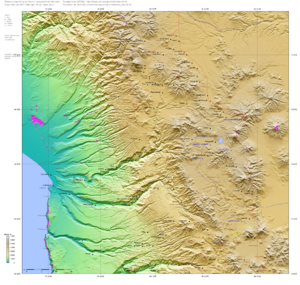Azapa Valley facts for kids
Azapa Valley is a special green area, like an oasis, in the Arica y Parinacota Region of Chile. It's surrounded by dry hills and has the San Jose River flowing through it, especially in summer. This valley is only about 3 kilometers (2 miles) from the city of Arica.
This amazing place in northern Chile has a unique climate. It allows farmers to grow many different fruits and vegetables all year long! It's also famous for its unique Azapa olives. These olives are known for their purple color and slightly bitter taste. They are also used to make a rich olive oil.
Contents
Exploring Azapa Valley
Ancient Discoveries
The Azapa Valley is a very important place for history and archaeology. Some of the world's oldest mummies were found here! These mummies belong to the ancient Chinchorro culture. You can see many of them at the Museo Arqueológico San Miguel de Azapa in Arica.
Many old ruins from the Chiribaya culture (who lived here between 900 and 1400 CE) can also be found in the Azapa Valley.
Parinacota: A Town of Crafts
One of the most interesting places in Azapa is the Andean town of Parinacota. It's the hometown of a famous craftsman named Jose Raul Naranjo Meneses. This town is full of talented craftspeople!
If you walk around Parinacota, you'll find many different handmade items. These include stone and wood sculptures, copies of ancient artifacts, musical instruments called ocarinas, and special pottery from northern Chile. You can also find designs on fabric, weavings, and crafts made from metal. Many of these items are made right there in front of you!
Parinacota also has a famous restaurant called "the Inn." It serves typical Chilean meals and international dishes. It's open most days, but it closes for a siesta (a short nap) in the afternoon.
Other cool spots in the region include Chuño Hill, which has many ancient rock carvings called petroglyphs. There's also the Gorge of Acha, where you can see large ground drawings called geoglyphs and learn about prehistoric camps.
Cerro Sombrero: Hat Hill's Secrets
Another amazing place is Cerro Sombrero, which means "Hat Hill." This hill has more geoglyphs and the remains of an ancient village. This village was built on the side of the hill with wooden homes on natural stone terraces.
Studies show that this village might have had as many as 500 houses between 1000 and 1400 A.D. This was an important time for the Arica culture. The people who lived here were farmers. They traded a lot with people from the high Andes mountains.
They used llama caravans to carry goods. The llamas brought things like dried meat (charqui), quínoa, and wool down from the mountains. In return, the people from the coast and valleys traded maize (corn), red pepper, fish, and seafood.
You can see stone figures called Atoca here. They show a typical llama caravan with its guide, and two dancers. These figures tell the story of the busy trade routes between the coastal people and the mountain people.
In the Pampas Alto Ramirez area, there are also impressive geoglyphs on sacred hills. These drawings show human and animal figures like llamas, snakes, and lizards. They date back to the time of Inca influence (1,000 - 1,400 AD).
San Miguel de Azapa: History and Plants
This town is about 12 kilometers (7.5 miles) from Arica. It's surrounded by beautiful farms. San Miguel de Azapa is known for growing subtropical plants and for its ancient burial mounds called túmulos.
It's also home to the Archaeological Museum of San Miguel de Azapa. This museum is part of the Universidad de Tarapacá. It shows the full story of how people and cultures developed in this region over the last 10,000 years. The famous Chinchorro mummies are also displayed here. Visiting this museum helps you understand a lot about the history of this part of the world.
Las Peñas of Livilcar Sanctuary
This sanctuary is about 80 kilometers (50 miles) from Arica. It's a special place where people celebrate the Virgin of the Rosary of Las Peñas (The Rocks). This celebration happens every year between the first Sunday of October and December 8.
See also
In Spanish: Valle de Azapa para niños



